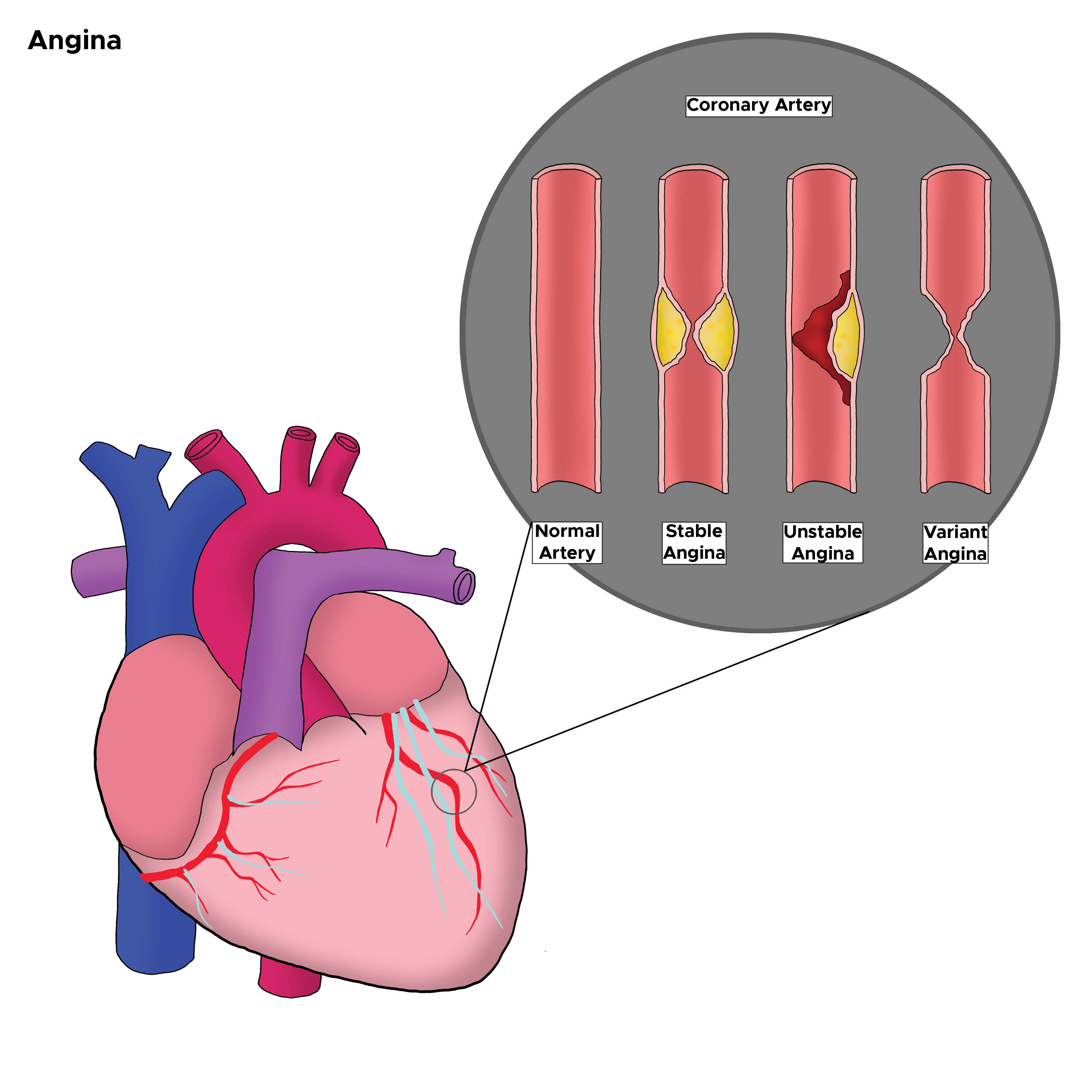[1]
Kloner RA,Chaitman B, Angina and Its Management. Journal of cardiovascular pharmacology and therapeutics. 2017 May;
[PubMed PMID: 28196437]
[2]
Ibáñez B,Heusch G,Ovize M,Van de Werf F, Evolving therapies for myocardial ischemia/reperfusion injury. Journal of the American College of Cardiology. 2015 Apr 14;
[PubMed PMID: 25857912]
[3]
Benjamin EJ,Virani SS,Callaway CW,Chamberlain AM,Chang AR,Cheng S,Chiuve SE,Cushman M,Delling FN,Deo R,de Ferranti SD,Ferguson JF,Fornage M,Gillespie C,Isasi CR,Jiménez MC,Jordan LC,Judd SE,Lackland D,Lichtman JH,Lisabeth L,Liu S,Longenecker CT,Lutsey PL,Mackey JS,Matchar DB,Matsushita K,Mussolino ME,Nasir K,O'Flaherty M,Palaniappan LP,Pandey A,Pandey DK,Reeves MJ,Ritchey MD,Rodriguez CJ,Roth GA,Rosamond WD,Sampson UKA,Satou GM,Shah SH,Spartano NL,Tirschwell DL,Tsao CW,Voeks JH,Willey JZ,Wilkins JT,Wu JH,Alger HM,Wong SS,Muntner P, Heart Disease and Stroke Statistics-2018 Update: A Report From the American Heart Association. Circulation. 2018 Mar 20;
[PubMed PMID: 29386200]
[4]
Lopez AD,Mathers CD,Ezzati M,Jamison DT,Murray CJ, Global and regional burden of disease and risk factors, 2001: systematic analysis of population health data. Lancet (London, England). 2006 May 27;
[PubMed PMID: 16731270]
Level 1 (high-level) evidence
[5]
Ganz P,Abben RP,Barry WH, Dynamic variations in resistance of coronary arterial narrowings in angina pectoris at rest. The American journal of cardiology. 1987 Jan 1;
[PubMed PMID: 3101476]
[6]
Hillis LD,Braunwald E, Coronary-artery spasm. The New England journal of medicine. 1978 Sep 28;
[PubMed PMID: 210380]
[8]
Crea F,Gaspardone A,Kaski JC,Davies G,Maseri A, Relation between stimulation site of cardiac afferent nerves by adenosine and distribution of cardiac pain: results of a study in patients with stable angina. Journal of the American College of Cardiology. 1992 Dec;
[PubMed PMID: 1452922]
[9]
Kreiner M,Okeson JP,Michelis V,Lujambio M,Isberg A, Craniofacial pain as the sole symptom of cardiac ischemia: a prospective multicenter study. Journal of the American Dental Association (1939). 2007 Jan;
[PubMed PMID: 17197405]
Level 2 (mid-level) evidence
[10]
Constant J, The clinical diagnosis of nonanginal chest pain: the differentiation of angina from nonanginal chest pain by history. Clinical cardiology. 1983 Jan;
[PubMed PMID: 6831781]
[11]
Christie LG Jr,Conti CR, Systematic approach to evaluation of angina-like chest pain: pathophysiology and clinical testing with emphasis on objective documentation of myocardial ischemia. American heart journal. 1981 Nov;
[PubMed PMID: 7304398]
Level 1 (high-level) evidence
[12]
LaCroix AZ,Lang J,Scherr P,Wallace RB,Cornoni-Huntley J,Berkman L,Curb JD,Evans D,Hennekens CH, Smoking and mortality among older men and women in three communities. The New England journal of medicine. 1991 Jun 6;
[PubMed PMID: 2030718]
[13]
Sotos-Prieto M,Bhupathiraju SN,Mattei J,Fung TT,Li Y,Pan A,Willett WC,Rimm EB,Hu FB, Changes in Diet Quality Scores and Risk of Cardiovascular Disease Among US Men and Women. Circulation. 2015 Dec 8;
[PubMed PMID: 26644246]
Level 2 (mid-level) evidence
[14]
Whelton PK,Carey RM,Aronow WS,Casey DE Jr,Collins KJ,Dennison Himmelfarb C,DePalma SM,Gidding S,Jamerson KA,Jones DW,MacLaughlin EJ,Muntner P,Ovbiagele B,Smith SC Jr,Spencer CC,Stafford RS,Taler SJ,Thomas RJ,Williams KA Sr,Williamson JD,Wright JT Jr, 2017 ACC/AHA/AAPA/ABC/ACPM/AGS/APhA/ASH/ASPC/NMA/PCNA Guideline for the Prevention, Detection, Evaluation, and Management of High Blood Pressure in Adults: A Report of the American College of Cardiology/American Heart Association Task Force on Clinical Practice Guidelines. Hypertension (Dallas, Tex. : 1979). 2018 Jun;
[PubMed PMID: 29133356]
Level 3 (low-level) evidence
[15]
Ninomiya T,Perkovic V,Turnbull F,Neal B,Barzi F,Cass A,Baigent C,Chalmers J,Li N,Woodward M,MacMahon S, Blood pressure lowering and major cardiovascular events in people with and without chronic kidney disease: meta-analysis of randomised controlled trials. BMJ (Clinical research ed.). 2013 Oct 3;
[PubMed PMID: 24092942]
Level 1 (high-level) evidence
[16]
Hennekens CH,Pfeffer MA,Newcomer JW,Jellinger PS,Garber A, Treatment of diabetes mellitus: the urgent need for multifactorial interventions. The American journal of managed care. 2014 May;
[PubMed PMID: 25181565]
[17]
Hennekens CH,Andreotti F, Leading avoidable cause of premature deaths worldwide: case for obesity. The American journal of medicine. 2013 Feb;
[PubMed PMID: 23331433]
Level 3 (low-level) evidence
[18]
Manson JE,Hu FB,Rich-Edwards JW,Colditz GA,Stampfer MJ,Willett WC,Speizer FE,Hennekens CH, A prospective study of walking as compared with vigorous exercise in the prevention of coronary heart disease in women. The New England journal of medicine. 1999 Aug 26;
[PubMed PMID: 10460816]
[19]
Guirguis-Blake JM,Evans CV,Senger CA,O'Connor EA,Whitlock EP, Aspirin for the Primary Prevention of Cardiovascular Events: A Systematic Evidence Review for the U.S. Preventive Services Task Force. Annals of internal medicine. 2016 Jun 21;
[PubMed PMID: 27064410]
Level 1 (high-level) evidence
[20]
Baigent C,Blackwell L,Collins R,Emberson J,Godwin J,Peto R,Buring J,Hennekens C,Kearney P,Meade T,Patrono C,Roncaglioni MC,Zanchetti A, Aspirin in the primary and secondary prevention of vascular disease: collaborative meta-analysis of individual participant data from randomised trials. Lancet (London, England). 2009 May 30
[PubMed PMID: 19482214]
Level 1 (high-level) evidence
[21]
Huang WY,Saver JL,Wu YL,Lin CJ,Lee M,Ovbiagele B, Frequency of Intracranial Hemorrhage With Low-Dose Aspirin in Individuals Without Symptomatic Cardiovascular Disease: A Systematic Review and Meta-analysis. JAMA neurology. 2019 May 13
[PubMed PMID: 31081871]
Level 1 (high-level) evidence
[22]
Collaborative meta-analysis of randomised trials of antiplatelet therapy for prevention of death, myocardial infarction, and stroke in high risk patients. BMJ (Clinical research ed.). 2002 Jan 12;
[PubMed PMID: 11786451]
Level 1 (high-level) evidence
[23]
Collins R,Reith C,Emberson J,Armitage J,Baigent C,Blackwell L,Blumenthal R,Danesh J,Smith GD,DeMets D,Evans S,Law M,MacMahon S,Martin S,Neal B,Poulter N,Preiss D,Ridker P,Roberts I,Rodgers A,Sandercock P,Schulz K,Sever P,Simes J,Smeeth L,Wald N,Yusuf S,Peto R, Interpretation of the evidence for the efficacy and safety of statin therapy. Lancet (London, England). 2016 Nov 19;
[PubMed PMID: 27616593]
[24]
Bangalore S,Fakheri R,Wandel S,Toklu B,Wandel J,Messerli FH, Renin angiotensin system inhibitors for patients with stable coronary artery disease without heart failure: systematic review and meta-analysis of randomized trials. BMJ (Clinical research ed.). 2017 Jan 19;
[PubMed PMID: 28104622]
Level 1 (high-level) evidence
[25]
Hauf-Zachariou U,Blackwood RA,Gunawardena KA,O'Donnell JG,Garnham S,Pfarr E, Carvedilol versus verapamil in chronic stable angina: a multicentre trial. European journal of clinical pharmacology. 1997;
[PubMed PMID: 9174677]
[26]
Abrams J, Hemodynamic effects of nitroglycerin and long-acting nitrates. American heart journal. 1985 Jul;
[PubMed PMID: 3925741]
[27]
Chaitman BR,Pepine CJ,Parker JO,Skopal J,Chumakova G,Kuch J,Wang W,Skettino SL,Wolff AA, Effects of ranolazine with atenolol, amlodipine, or diltiazem on exercise tolerance and angina frequency in patients with severe chronic angina: a randomized controlled trial. JAMA. 2004 Jan 21;
[PubMed PMID: 14734593]
Level 1 (high-level) evidence

